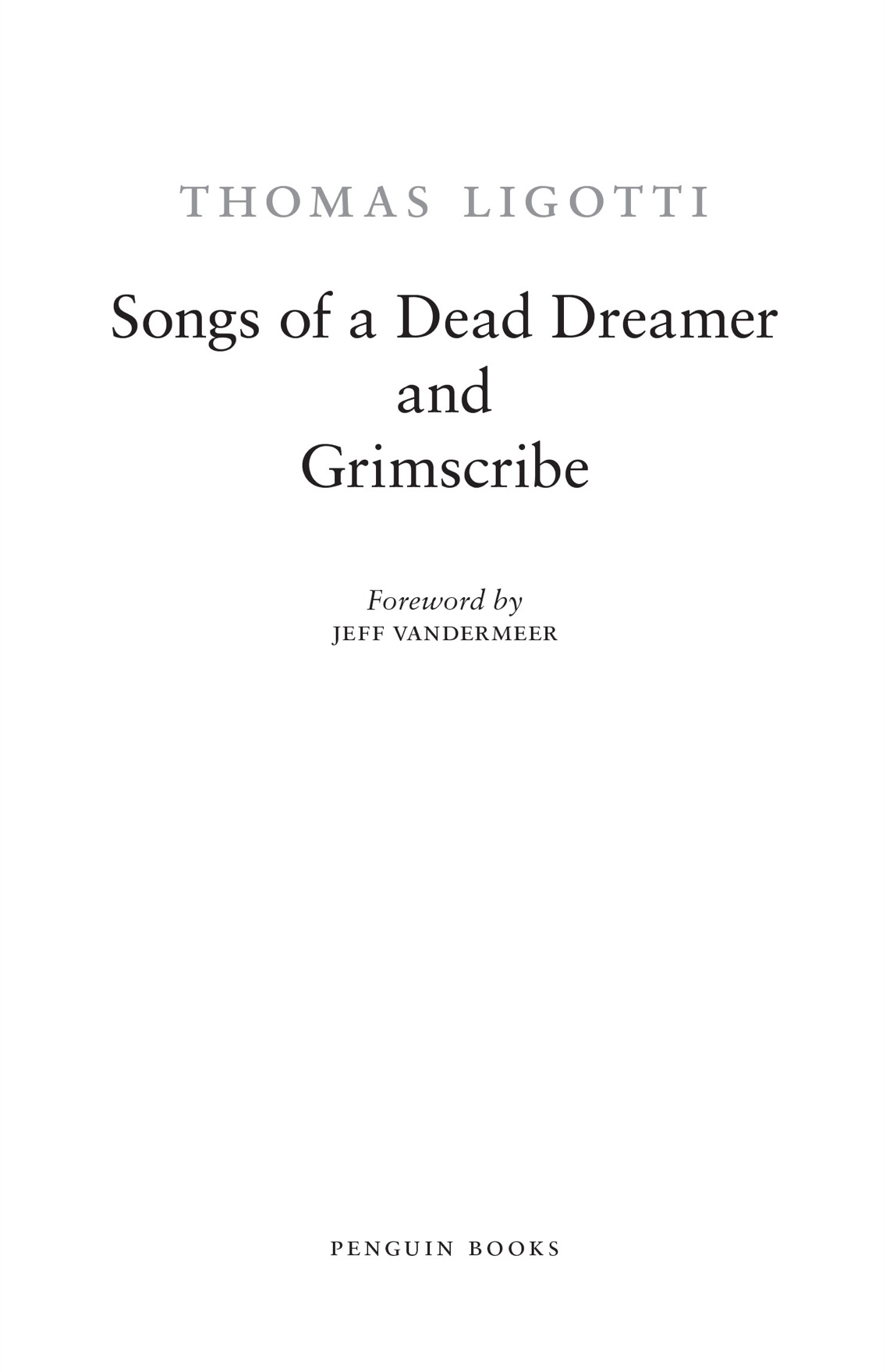PENGUIN  CLASSICS
CLASSICS
SONGS OF A DEAD DREAMER and GRIMSCRIBE
THOMAS LIGOTTI was born in Detroit in 1953. Considered one of the foremost authors of supernatural horror stories, he began publishing in the early 1980s. Following a tradition established by Edgar Allan Poe and perpetuated by H. P. Lovecraft, Ligotti is noted for his portrayals of characters who are outsiders to ordinary life, depictions of otherworldly dimensions, and uniquely dark vision of human life. His works are often praised by critics for their richly inventive imagination and evocative prose. Ligottis first collection of tales, Songs of a Dead Dreamer, was published in 1985, and its follow-up, Grimscribe, in 1991. Among his other publications are the collections Noctuary and Teatro Grottesco as well as an influential philosophical work, The Conspiracy Against the Human Race: A Contrivance of Horror. Ligotti has received several awards, including the Horror Writers Associations Bram Stoker Award for his omnibus collection The Nightmare Factory and his short novel My Work Is Not Yet Done. He lives in Florida.
JEFF VANDERMEER S most recent fiction is the New York Timesbestselling Southern Reach trilogy (Annihilation, Authority, and Acceptance). His nonfiction has appeared in TheNew York Times, TheGuardian, TheWashington Post, TheAtlantic.com, and the Los Angeles Times. VanderMeer has edited or coedited many iconic fiction anthologies, taught at the Yale Writers Conference and the Miami International Book Fair, lectured at MIT and the Library of Congress, and serves as the codirector of Shared Worlds, a unique teen writing camp located at Wofford College. He lives in Tallahassee, Florida, with his wife, the noted editor Ann VanderMeer.
PENGUIN BOOKS
An imprint of Penguin Random House LLC
375 Hudson Street
New York, New York 10014
penguin.com
Copyright 1986, 1989, 1991, 1996, 2010, 2011 by Thomas Ligotti
Foreword copyright 2015 by Jeff VanderMeer
Penguin supports copyright. Copyright fuels creativity, encourages diverse voices, promotes free speech, and creates a vibrant culture. Thank you for buying an authorized edition of this book and for complying with copyright laws by not reproducing, scanning, or distributing any part of it in any form without permission. You are supporting writers and allowing Penguin to continue to publish books for every reader.
Songs of a Dead Dreamer was first published in the United States of America by Silver Scarab Press in 1986. A revised edition with a different selection of stories was published in Great Britain by Robinson Publishing in 1989 and in the United States by Carroll & Graf in 1990. A second revised version with different content was published in Thomas Ligottis The Nightmare Factory by Carroll & Graf in 1996. A third revised version was published in the United States by Subterranean Press in 2010.
Grimscribe was first published in Great Britain by Robinson Publishing in 1991 and in the United States by Carroll & Graf in 1991. A revised version was published in The Nightmare Factory by Carroll & Graf in 1996. A second revised version was published by Subterranean Press in 2011.
LIBRARY OF CONGRESS CATALOGING-IN-PUBLICATION DATA
Ligotti, Thomas.
[Short stories. Selections]
Songs of a dead dreamer: and, Grimscribe / Thomas Ligotti ; foreword by Jeff Vandermeer.
pages ; cm.(Penguin classics)
ISBN 978-0-698-40928-6
I. Ligotti, Thomas. Grimscribe. II. Title. III. Title: Grimscribe.
PS3562.I4546A6 2015
813'.54dc23
2015018805
These selections are works of fiction. Names, characters, places, and incidents either are the product of the authors imagination or are used fictitiously, and any resemblance to actual persons, living or dead, businesses, companies, events, or locales is entirely coincidental.
Cover illustration: Chris Mars/Chris Mars Publishing, Inc.
Version_1
Foreword
Over the past thirty years, Thomas Ligotti has produced an extraordinary body of work in the short story formevidenced herein by his first two collections, Songs of a Dead Dreamer ( 1985 ) and Grimscribe: His Lives and Works ( 1991 ). Songs was first published by Harry O. Morriss Silver Scarab Press in a three-hundred-copy edition with cover art and illustrations by Morris and an introduction by Ramsey Campbell. The book received its due acclaim after a wider release in 1989 , but the first edition remains a jewel within our book collection. I remember leafing through it and feeling as if I were looking at an artifact that had slipped through from another universe. Grimscribe was, at the time of publication, seen by some as a typical second book, as if Ligotti had taken a step back in quality. Over time, however, readers and critics have recognized that the collection is, if anything, richer, more focused, and more mature than Songs.
Where within the fictional cosmos do Ligottis stories exist? The same fixed, timeless position as those of Edgar Allan Poe and Franz Kafka. Like that of Poe and Kafka, his fiction is transformative by virtue of the authors unique way of seeing the world and because it is innovative in ways both visible (formal experimentation) and invisible (stealth experiments that reveal their presence only by how they affect the reader). Unlike with Poes fiction, this quality in Ligottis work cannot be emulated in any meaningful way and ferociously resists commodification by the marketplace. Unlike in Kafkas stories, Ligottis prose is too uncomfortably visceral and (although deeply absurdist at times) too hostile to a certain kind of playfulness to enter into the traditional canon. But in all three cases, a unique voice at the right distance from its subject matter prevents the work from becoming dated. A deliberate lack of specificity follows from the authors natural preoccupations. Unnamed narrators and nameless towns, for example, allow for a corresponding vagueness of either character or setting that, perversely, creates the necessary anchor for even a reader a century from now, traveling beneath strange stars, to be held in thrall.
Perhaps these qualities also reflect that although Ligotti came out of the weird and uncanny genres, he was always passing through those regions. Recalling the horror scene in the mid- 1980 s through the mid- 1990 s, I remember that it was marked by a certain conservativism and a general devotion to naturalism. In its most extreme manifestations, this worship of pragmatic causality became the hyperrealism of subgenres devoted to depicting explicit violence and sex. Set against such trends were a handful of unique voices, including writers like Kathe Koja, Caitln R. Kiernan, Poppy Z. Brite, and Clive Barker, who at times added elements of the surreal, Decadent, New Gothic, or genuinely transgressive body horror.
Did Ligotti come out of this community? Not really. His work, sui generis, just happened to be published in those environs during that time period. To suggest otherwise would be like saying there is huge significance to the neighborhood in which a physicist lives when he has a eureka moment due to research at his laboratory. In this sense Ligotti is allied with iconoclasts like Angela Carter, Haruki Murakami, the aforementioned Kafka, Alfred Kubin, and, to some extent, the great Bruno Schulz. Indeed, brilliant one-off texts like Sakutaro Hagiwaras dreamlike The Town of Cats ( 1935 ) and Eric Bassos preternaturally Proustian The Beak Doctor ( 1977 ) seem oddly Ligotti-esque even if they are not direct influencesprecisely because, like Ligottis work, they exist in a unique space between horror and the surreal, between the visceral and the philosophical. It is a special place, found on no map, where the supernatural resists being labeled and every attempt at naming leaves the formal inquest flummoxed as to whether a particular shadow or reflection was part of the natural or unnatural worlds.

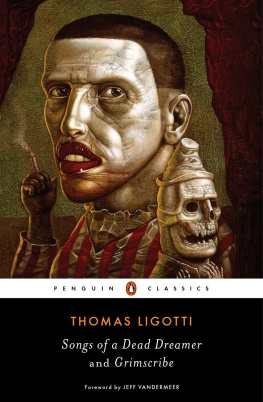
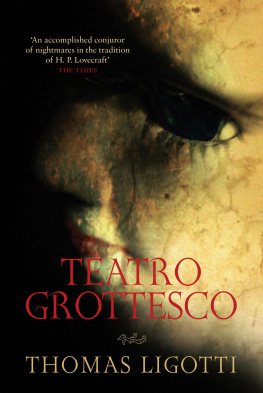
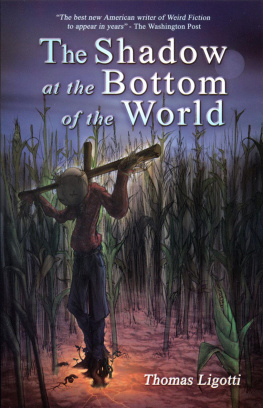
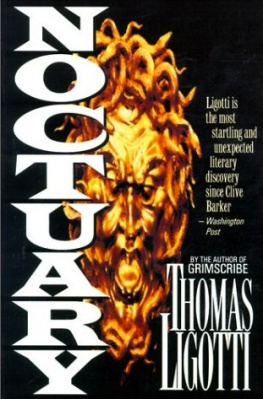
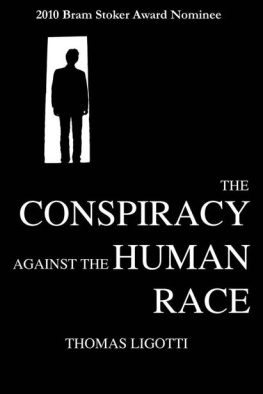

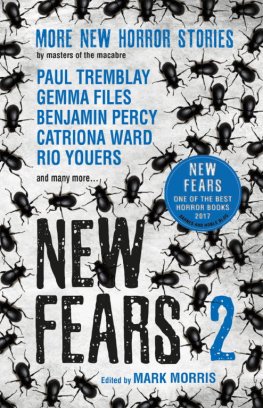

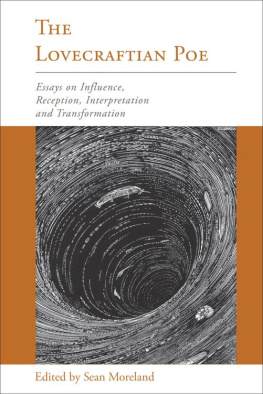
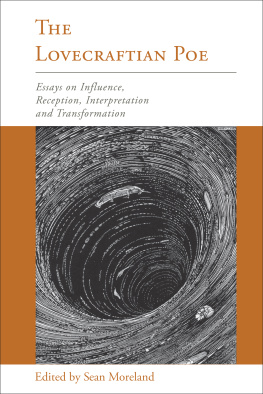
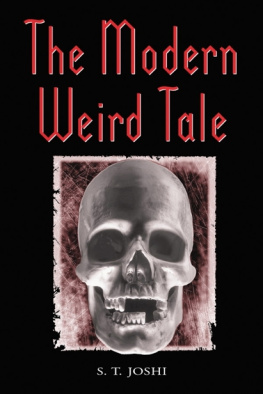
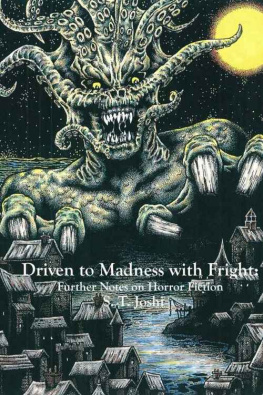

 CLASSICS
CLASSICS